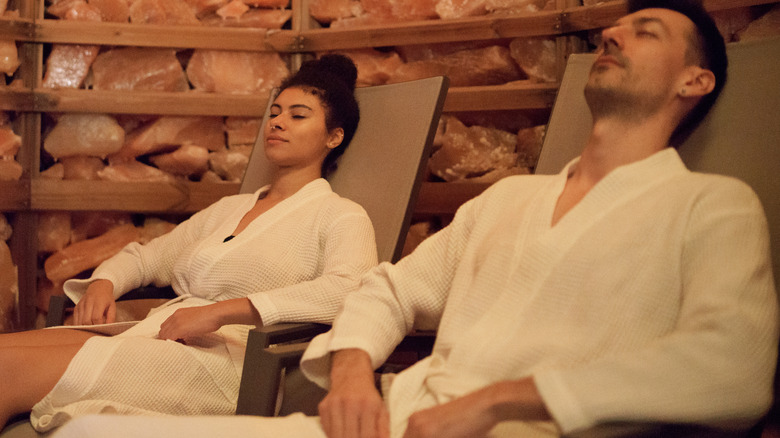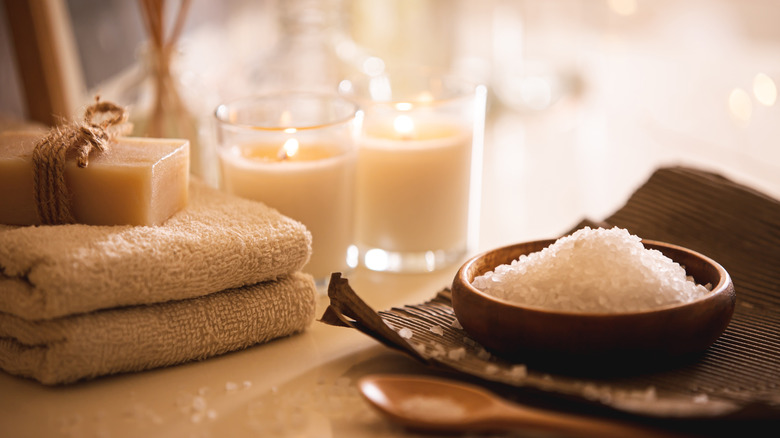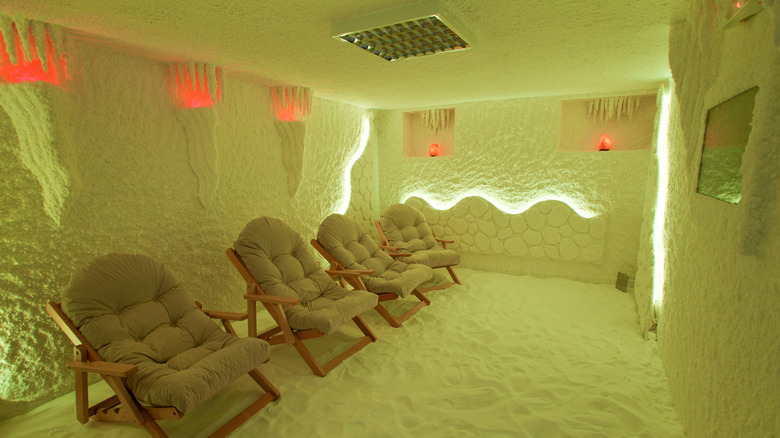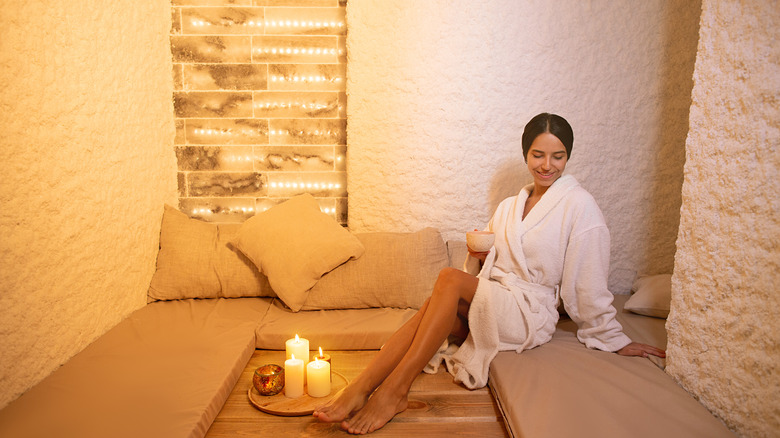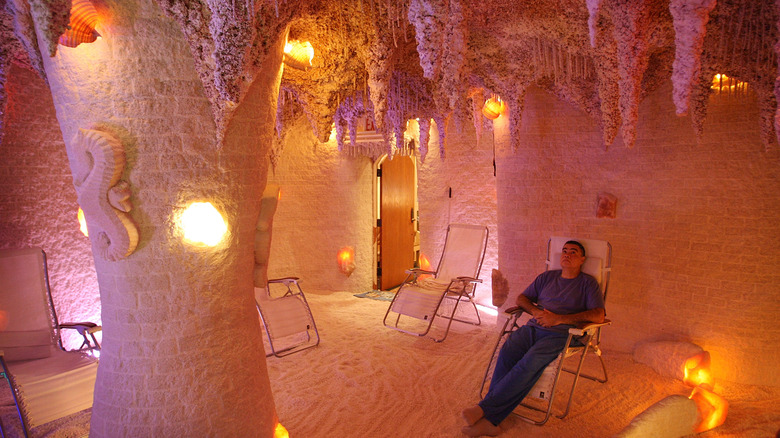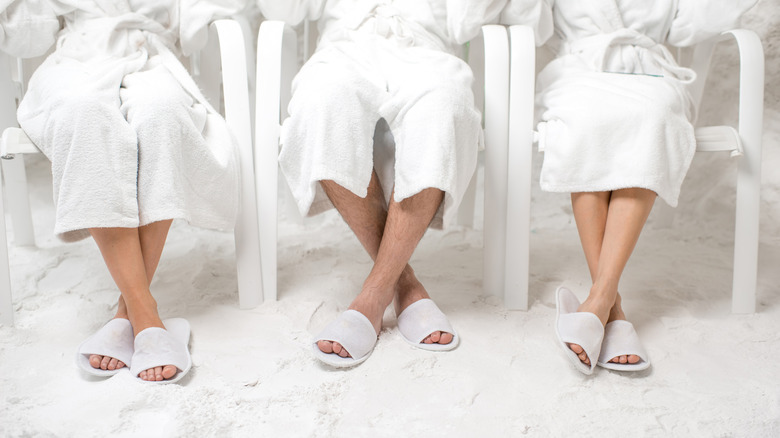Salt Caves Are The Newest Wellness Trend Striving To Breathe New Life Into You
In addition to massages, many wellness centers and spas are adding new therapies to their list of services. Float tanks, cryotherapy, and infrared saunas are some examples of wellness treatments intended to heal and soothe the mind, body, and soul. However, the newest wellness trend — salt cave therapy — is quickly emerging on the scene as a natural approach to wellness.
Dating back centuries ago to Eastern Europe's salt caves, this global trend is growing in popularity in the U.S. due to its many health benefits. We all know how great we feel after a day at the beach breathing in the salty air and swimming in the salt water. Salt cave therapy is like a concentrated version of a day at the beach in one tranquil salt room made to resemble the salt caves of Europe. The benefits of salt therapy have been used for years around the world to treat a number of ailments. Before your first session is booked, here's what you need to know about salt caves.
What is salt therapy?
There are actually two types of salt therapy: wet salt therapy and dry salt therapy. You may have heard (or even tried) some of the various wet salt therapies out there, including float tanks, nettie pots, nebulizer treatments, salt baths, and exfoliation. Many people use these wet salt therapies to help with respiratory conditions, improve skin health, and sometimes boost mental health.
Dry salt therapy, on the other hand, is managed in a moisture-free and humidity-free atmosphere referred to as salt rooms or salt caves. While the research is ongoing, people use dry salt therapy for many of the same ailments as wet salt therapy. Because it's so effective that various wellness places around the world have started to provide dry salt therapy. Day spas, wellness centers, fitness clubs, and even yoga studios are some of the places you can find dry salt therapy. This all-natural treatment has many people coming back for more after they see the effects that salt has on the body.
The two types of dry salt therapy
Dry salt therapy is then further split into two categories: halotherapy and speleotherapy. According to the Salt Therapy Association, halotherapy, or an active salt room, uses a halogenerator to produce a "combination of micronized salt and air that is dispersed in the salt room". These micro-particles are easily absorbed through the skin and lungs. Because the effectiveness of salt therapy is based on those micro-sized salt particles being absorbed by our body, halotherapy is primarily used in salt rooms around the world.
Speleotherapy is used in a more natural environment, using large amounts of varying types of salt including rock salt and pink Himalayan salt brought in to resemble a salt cave. These passive salt rooms do not use a halogenerator to produce the salt particles in the air. Speleotherapy only uses natural elements such as atmospheric pressure and air temperature to control the climate. So, the benefits of this type of environment are more for meditation, relaxation, and mental well-being.
Respiratory benefits of salt caves
Salt cave therapy is based on the salt caves and mines of Eastern Europe. In the 1800s, a Polish doctor noticed that the workers mining in these caves, breathing in the micro-sized salt particles as they chiseled the walls, received many health benefits (via the Salt Therapy Association). He noted that the miners had great respiratory health, which was an anomaly considering that most miners had breathing issues due to their working environments. Another German doctor in the early 1900s also noted the respiratory health benefits the people working in the salt caves received.
Why do salt caves offer so many health benefits to our lungs? Salt helps reduce inflammation and is also antibacterial, antiviral, antifungal, and antimicrobial, per Float State. The salt draws out toxins from the lungs, decreases inflammation, and clears the airway. Additionally, you also absorb the minerals in the salt while breathing the micro-particles. Some of the minerals in salt include iron, potassium, sodium chloride, magnesium, and calcium.
Halotherapy may help relieve asthma, allergies, sinus inflammation, coughs, and respiratory infections. However, always consult with your doctor or provider before trying halotherapy to treat any condition.
Additional health benefits of salt caves
Not only does salt cave therapy improve respiratory health, this therapy is also good for our skin. Remember that Polish doctor who first noticed salt miner's respiratory health in the 1800s? He also noted that the salt miners had great skin appearance and looked younger compared to other miners who did not work in the salt caves.
According to Float State, people can find relief from common skin ailments such as acne, psoriasis, and eczema when they visit salt caves. The micro-particles in the salt caves have positive benefits on our skin because salt is so absorbent. The dry salt is able to "improve skin rigidity," and provide rejuvenation due to the micro-particles reaching beneath the skin's surface to absorb impurities, per the Salt Therapy Association.
Salt cave therapy is also extremely calming and relaxing, providing you with time to unwind. Salt therapy helps to reduce anxiety and depression due to the negative ions in salt. Serotonin, colloquially known as the body's happy hormone, is released when negatively charged ions enter the body.
A tour inside a salt cave
So what does a salt cave look like? While every salt cave will look a little different depending on where you go, most aim to mimic the Eastern European caves. Many spas use pink Himalayan salt bricks to make the walls of the room. Loose salt covers the ground you walk on, ranging from fine salt to crushed pebbles. The rooms are usually lit with rock salt lamps to provide a dim and calming atmosphere. You may also hear peaceful music or nature sounds playing in the background.
The air is dry and cool, usually set around 68 degrees to mimic a cave. Of course, a salt cave can not be complete without actual halotherapy. You will not be able to see it, but a halogenerator is working behind the scenes to pump the salt micro-particles into the air. Some spas even provide a separate salt cave experience designed for children to enjoy the benefits of salt therapy. These special salt rooms can include a theme such as pirates or under-the-sea, sand toys to play with, and cartoon murals of caves on the walls.
What to expect at your first salt cave experience
If this is your first time visiting a salt cave, there are a few things you'll want to take note of before the session. Once you have the day and time booked, try to arrive about 15 minutes early to get prepared — and in case you have to fill out any waivers or forms. It's best to wear comfortable, loose-fitting clothes. You will be asked to take off your shoes before entering the salt cave, and each facility will have different rules about wearing socks, slippers, or going barefoot.
Be prepared to leave the digital world behind once you enter the salt cave for your 45-minute session. The use of electronics can diminish the tranquil experience, so be sure to make any arrangements before your appointment. After you enter the salt cave, find a spot to relax on one of the lounge chairs or benches around the room. Sometimes you are provided robes or blankets due to the cool temperature. Many people prefer to lie on the salt floor to really get the most out of the experience. Feel free to nap, read, or meditate as you reap the full benefits of salt cave therapy. After your session, you should feel renewed, relaxed, and lighter. You'll likely need to drink plenty of water after your salt cave therapy to replenish lost fluids.
